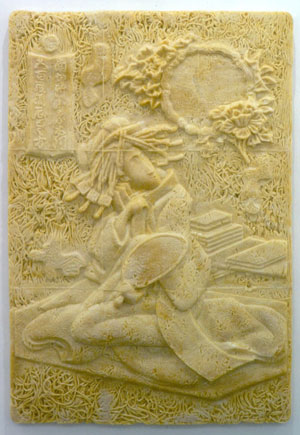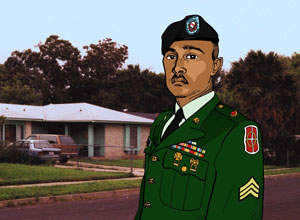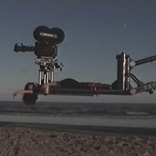In this most recent installment of the ArtPace residency program, curator Francesco Bonami has chosen three emerging artists whose works explore the relation between sensory perception and material reality.

Giuseppe Gabellone, Untitled 1, 2002...Rigid urethane foam, 50 1/2 x 34 1/2 x 1 3/4 in. ...Originally commissioned by ArtPace, A Foundation for ...Contemporary Art
Refreshingly modest and tactfully edited, the exhibition features a single work by each artist. In all three projects, the space between seeing, and understanding what you are seeing, is expansive, with much room for interpretation in and around the artists” more apparent intentions.
In Gallery 1, making use of his skills as a mold-maker, Giuseppe Gabellone has transformed two 18th century Japanese woodblock prints into 3-dimensional relief panels, which appear to be formed out of cold, cooked pasta noodles. At first glance, the untitled panels read as polished stone, but a closer inspection reveals them to be unmistakably all about spaghetti. Molded on the surface of each panel are two Japanese geishas, both with averted glances as if in a daydream. The panels themselves seem to vacillate on the nature of their own materiality, appearing on one hand as a more formally open experiment in the tradition of Arte Povera, and on the other in allegiance with the longstanding tradition of Italian classical sculpture. Ultimately, the hard-edged formalities are undercut by the odd hybrid of wildly disparate cultural references, creating a new place for objecthood, history, and fusion food.

Aïda Ruilova’s video work in Gallery 2 is preceded by the sound of deep, concentrated, heavy breathing. Led by the breathing, turning into the dark space, one is faced with a large-scale projection on one of the gallery walls. In it, a female figure is asleep (or is she dead?) on what appears to be the arm of a crane used in filmmaking for those ‘swooping-in” sorts of shots. In what is the most conceptually enigmatic and challenging work in the exhibition, Ruilova’s piece suggests several meanings and modes of interpretation.
Against what appears to be an open sky at either dusk or dawn, the arm of the crane sweeps in from the upper right corner of the screen. Roughly cut in a series of jerky motions that synchronize with the breathing, the film continues to pan to the left and down, revealing a beach below the crane. The sleeping rider lies precariously on the crane, just under the shadow of an actual film camera. As the breathing intensifies, the crane moves up and down, backwards and forwards, in an endless sort of repetition with the intention of either gently shaking the woman lose, or lulling her into ever deeper slumber.

Juan Miguel Ramos, Southside Lotería (El Soldado), 2002...Double video projection, two DVDs, and synchronizer...6 min. 40 sec. (Still)
The relationship between the portion of the crane that we see (which suggests a much larger machine off camera) and the sleeping woman is a relationship between beast and beloved. Like a mechanical King Kong, the crane seems to be torn between the impulse to settle the sleeping woman in the sand, and the desire to hold her in its keep. The sound of the breathing blurs the line between sexual ecstasy and bodily injury, and it is unclear which (if not both) the breather is experiencing.
As Baudrillard notes in Simulations, “Illusion is no longer possible, because the real is no longer possible.” Ruilova’s work suggests the possibility of this impossibility by suggesting that the constructors of media, myth, culture, and illusion hold us asleep in their very arms.
Upstairs in a smaller gallery, Juan Miguel Ramos has created an intimate, carpeted screening room for a two-screen video projection that is the latest development in his series of two-dimensional character animations. Making use of friends, family, and acquaintances, Ramos has interviewed four subjects and allowed them to create their own free-form monologues. Titled collectively Southside Loteria, the video corresponds to four framed prints outside of the gallery, each a portrait of one of the characters in the video, titled separately La Dama, El Soldado, El Borracho, and La Sirena (each of which is a card in loteria, the Mexican game of bingo).
Though the video begins with a straightforward investigation of cultural and racial identity, it interrupts itself at certain points with personal comments by the subjects, opening up the work to a broader range of human experiences. Idiosyncratic and hilarious stories about foot massages, karaoke, and the Smiths are mixed with more critical comments on the effect of Tejano music and exploitation of the indigenous peoples of Mexico. By creating a space for the recording of their personal narratives, Ramos” characters identify most collectively with the culture of the self.
Images courtesy the artists and ArtPace.
Michael Velliquette is an artist and Co-Founder of The Bower, an artist-run exhibition space in San Antonio, along with Joey Fauerso and Leslee Fraser. He is also the Assistant Director of Finesilver / FYI in San Antonio.



